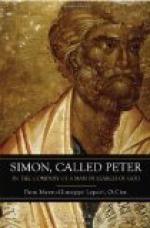“’And if the Wine you drink, the Lip you
press,
End in what All begins and ends in—Yes;
Think then you are To-day what Yesterday
You were—To-morrow you shall not be less,’”
he quoted.
“Yes,” said Peter. “Or else it means that there are only two realities, and that the excellent person who keeps this establishment regards both in a detached way, and conceives it her business to cater for each. Let’s go on.”
They turned the corner, and presently found themselves outside the famous carven door of the church. “Have you ever been round?” asked Peter.
“No,” said Langton; “let’s go in.”
They passed through the door into the old church, which, in contrast to that at Le Havre, was bathed in the daylight that streamed through many clear windows. Together they wandered round it, saying little. They inspected an eighteenth-century statue of St. Roch, who was pulling up his robe to expose a wound and looking upwards at the same time seraphically—or, at least, after the manner that the artist of that age had regarded as seraphic. A number of white ribbons and some wax figures of feet and hands and other parts of the body were tied to him. They stood before a wonderful coloured alabaster reredos of the fourteenth century, in which shepherds and kings and beasts came to worship at the manger. They had a little conversation as to the architectural periods of the nave, choir, and transepts, and Langton was enthusiastic over a noble pillar and arch. Beyond they gazed in silence at a statue of Our Lady Immaculate in modern coloured plaster, so arranged that the daylight fell through an unseen opening upon her. Among the objects in front were a pair of Renaissance candlesticks of great beauty. A French officer came up and arranged and lit a votive candle as they watched, and then went back to stand in silence by a pillar. The church door banged and two peasants came in, one obviously from the market, with a huge basket of carrots and cabbages and some long, thin French loaves. She deposited this just inside the door, took holy water, clattered up towards the high altar, dropped a curtsy, and made her way to an altar of the Sacred Heart, at which she knelt. Peter sighed. “Come on,” he said; “let’s get out.”
Langton marched on before him, and held the door back as they stepped into the street. “Well, philosopher,” he demanded, “what do you make of that?”




